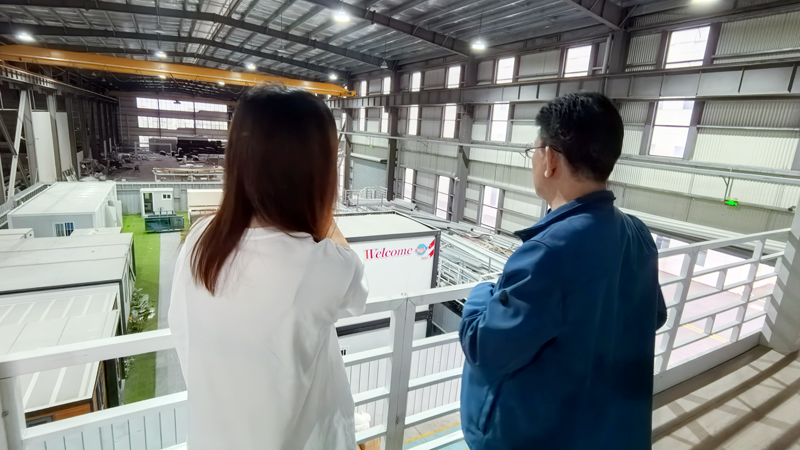California Client Visit and Discussion: Jointly Exploring New Opportunities in Modular Housing Policies and Cooperation
On October 16, 2025, client representatives from the modular construction industry in California, the United States, visited our facility. They toured the factory and conducted in-depth exchanges on California’s modular house policy developments, prefabricated building market trends, and potential cooperation opportunities for products like assemble container house. The discussions focused on the compatibility between policies related to Accessory Dwelling Units (ADUs) and modular house construction technologies, laying the foundation for future cooperation between the two parties.

During the exchanges, the clients expressed a profound understanding of the policy background and development opportunities in California’s modular house and prefabricated building markets. As is widely known, California has long been plagued by housing shortages and high housing prices. In response, the state has introduced a series of intensive policies in recent years to promote the development of modular house and prefabricated building industries: - The AB 2221 bill, which took effect in 2023, simplified the ADU approval process (applicable to modular house and small assemble container house projects). It specifies that licensing authorities must provide feedback on review results within 60 days and eliminates unreasonable approval barriers such as setback restrictions. - In 2023, the state government also allocated a $50 million special fund in its housing budget to provide a $40,000 subsidy per unit for eligible ADU builders—including those adopting prefabricated building solutions. However, the clients also acknowledged that despite the relaxed policies, there are discrepancies in regulations across California’s cities and counties for modular house and assemble container house projects. Additionally, strict technical requirements—such as structural standards and fire safety codes for prefabricated building in high-seismic-intensity areas—pose major challenges to market expansion.
We elaborated on how to align with California’s multi-level regulatory system for modular house and prefabricated building projects: from core state-level bills like AB 68 and SB 9 (which clarify compliance standards for modular house) to specific implementation rules in cities such as Los Angeles and San Francisco (for assemble container house adaptations). We can use digital tools to pre-verify the compliance of design plans (e.g., simulating parameters like lot setback requirements and height restrictions for modular house), shortening the cycle for policy alignment. Regarding technical compliance, we took the 11-story modular house hotel built by CIMC Group for Los Angeles as an example, introducing a new type of steel structure connection technology developed for high-seismic-intensity areas in prefabricated building. This technology meets California’s Seismic Design Category E standards (equivalent to China’s 8-9 degree seismic fortification) and complies with LEED green building certification requirements—critical for modular house and assemble container house projects in the state.
The clients also focused on inquiring about the efficiency and cost advantages of modular construction, especially for modular house and assemble container house products. In response, representatives from ZCS-MODULAR HOUSE explained that the model combining factory prefabrication (a core feature of prefabricated building) and on-site assembly reduces on-site construction time by 80%. For ADU units—including modular house and small-scale assemble container house models—ranging from 40 to 111 square meters, after one month of foundation construction, the main modules can be hoisted and installed within one day. Furthermore, through a strategy that combines standardized design (for prefabricated building) with limited customization (for modular house and assemble container house), we can not only meet the space adaptation needs of the California market but also control construction costs—offering significant cost-effectiveness compared to traditional construction methods. The clients expressed recognition of our technical solutions adapted to California’s policies for modular house and prefabricated building, and the two parties initially reached a cooperation intention targeting California’s ADU market, with follow-up plans to refine regulatory alignment and technical implementation details for assemble container house and other products. This visit by the California clients not only deepened the mutual understanding of Sino-US modular house, prefabricated building and assemble container house policies and technical standards between the two parties but also accurately aligned with the actual needs of California’s housing market. As California’s ADU policies continue to optimize and modular house/prefabricated building technologies mature, the two parties are expected to achieve collaborative development in areas such as compliant construction, cost control, and market expansion for assemble container house and beyond, jointly seizing the industry opportunities brought by California’s housing reform.